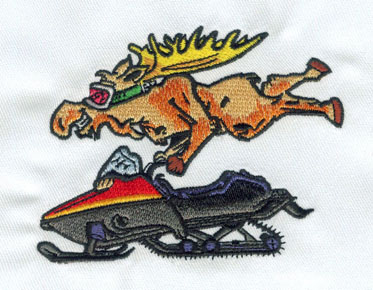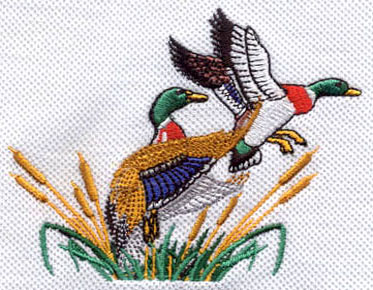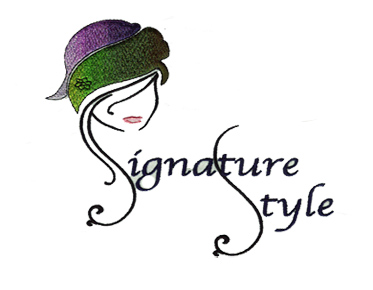How To Choose What Size Embroidery Needle to Use
For embroidery projects, you need the right needle to get the most out of your project. In addition to knowing how to select the right type of needle, you need to be sure the size and color are correct for the type of floss that you are using. This content also has some reference value for Eagle digitizing.
Embroidery
needles come in different sizes. We categorize them as ranges of numbers. The
lower the number, the larger the needle. The smaller the needle, the finer the
floss the needle will use for optimal embroidery on the fabric.
There are different embroidery needles. Read on to learn how to choose the best needle for your embroidery designs and projects.
Embroidery
needle or embroidery needle
Embroidery needles are the best for embroidery projects. You can recognize these needles by their wide eyes and sharp tips. Large hole openings facilitate threading and prevent floss breakage. The size of the embroidered floss depends on the number of strands you use. Large eye space allows several strands to pass through the needle. This point allows the needle to sew the fabric easily. We can use a sewing machine or use it by hand.
Chenille
needle
Chenille needles are like embroidery needles because they also have a little bit. However, the needles have much larger eyes than the crew. They are also shorter and wider. They are best used with wool embroidery. We often do chenille embroidery on college jackets to create large, colorful letters and numbers.
Tapestry needle
Like other embroidery needles, tapestry needles have a lot of eye space. The remarkable difference from other needles is that it has a blunt point. Tapestry needles are commonly used to stitch knitted fabrics together. Their large eyes make it easy to thread knitted yarn. Due to their blunt tips, they can easily pass through knitted fabrics without damaging them. An important feature of tapestry needles is that they look curved when you reach their tips.
Ribbon
embroidery needle
Ribbon is a common form of embroidery used in many sewing projects. A ribbon embroidery needle is the best needle for this embroidery project. They have huge eyes that can easily fit into embroidered ribbons.
Quilting
needle
Quilting is another embroidery technique that can be used for decorative sewing. The only difference is that it uses fabric instead of embroidered floss. Quilting needles have a round eye and they are short and thin.
How
to determine the size of embroidery needle
We
numbered the embroidery needles to show their size. The numbers range from 1 to
12. The higher the number on the needle, the smaller the needle. A 12-gauge
needle is much smaller than a 1-gauge needle. The smaller the needle, the
smaller the eye. Therefore, the finer the line you need. Large needle, small
quantity, suitable for thick fabric.
Tapestry pins are numbered from 18 to 28. Again, higher numbers indicate smaller needle sizes.
Always keep these numbers in mind when considering how to proceed with an embroidery project.
How
do I determine the size of the embroidery needle to use
We have seen different embroidery needles that can be used in sewing projects. Embroidery needles come in different sizes and are suitable for different projects. Several features of your project will determine the size of the needle you will use for embroidery
A lot of times when you sew, people use the wrong needle. Therefore, it is important to know the correct needle. This makes it easy for you to perform all sewing projects. Using the right needle makes the project easier to complete. Using the wrong needle can lead to problems such as breakage and poor workmanship.
The correct needle can enhance the reliability and improve the quality of the final product of embroidery.
What is embroidered floss
Embroidery floss uses six strands of yarn specifically for embroidery of sewing projects. Its strands are easily separated and can determine how many they want to use. This will also determine the size of the needle you will use for the project.
Using six-strand floss is difficult, though not impossible. For this, you will need a large needle with a large eye. This will ensure that your floss fits through the needle. For single strand, you will need a small embroidery needle for best experience and results.
Provides embroidery floss, usually made of cotton. It is also available in silk and linen, polyester and other materials.
When
you buy embroidery, make sure you buy the best quality you can afford. In
addition, there are a variety of different sizes and types of needles.
What
is the best fabric for embroidery?
Woven fabric
This is a high quality fabric, also known as even woven fabric. Even woven fabrics have even thread counts. This makes them easier to sew. With more count, woven fabrics feel smooth to the touch and produce high quality clothing fabrics.
They are the most commonly used fabrics for embroidery. They are easy to operate, and with the right needle type and size, you can get the best results.
Aidab
This is an easy-to-use fabric. Its preference comes from its accessibility and affordability. It is 100% cotton fabric with an easy-to-count thread pattern. This is the fabric that many sewers will use to learn embroidery. It also comes in an arbitrary number of colors. Many sewer workers like this fabric because the thread is in good shape and you can see where your needle goes on each stitch. Aida fabric is very hard.
Towel
Towel fabrics are perfect for embroidery projects. You can easily see the thread pattern. This allows you to quickly complete the embroidery on the fabric. The fabric is also readily available and affordable at craft stores.
What determines the success of embroidery
When you want to undertake a successful embroidery project, the first thing to consider is the fabric. Use good fabrics and you will get the best results. Poor quality fabrics are difficult to use to get the desired results. Purchase any of the above fabrics for smooth embroidery projects. When choosing the fabric to use, be aware of the thread number for excellent results. Choose fabrics with fewer than 150 threads for the best embroidery results.
Skill
level
To be good at something, you need to practice long enough. Sewing is a skill that takes a long time to master. The best embroidery comes from highly skilled sewers. Improve your embroidery skills and you will get excellent results for all embroidery projects.
Needle size
With
the right skills, you'll know that the success of your project depends on using
the right needle. Embroidery needles come in different sizes. Depending on the
type of fabric and embroidery you want, you will need to use the correct
needle. The right stitch ensures that your embroidery thread fits the fabric as
needed for best results.



